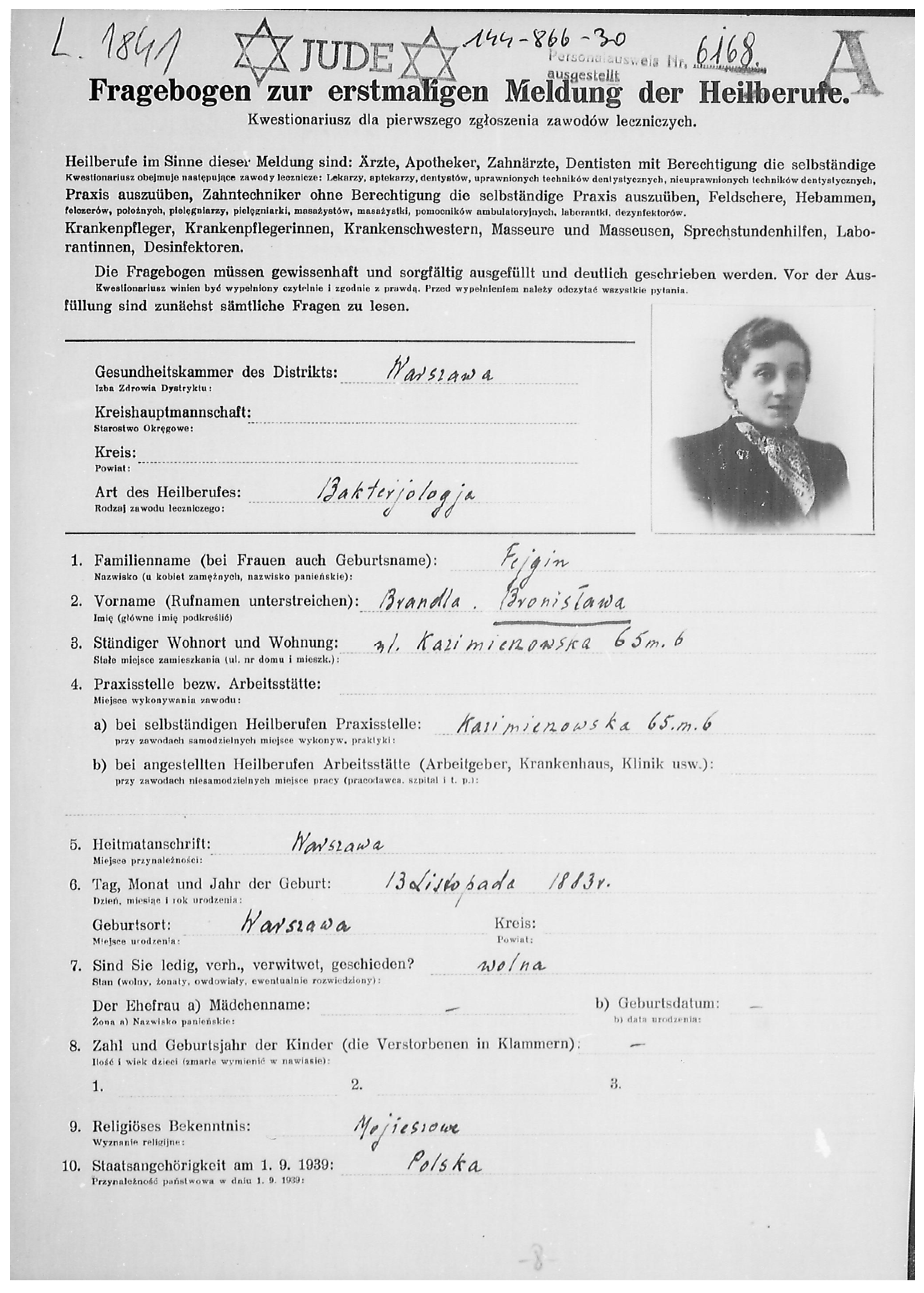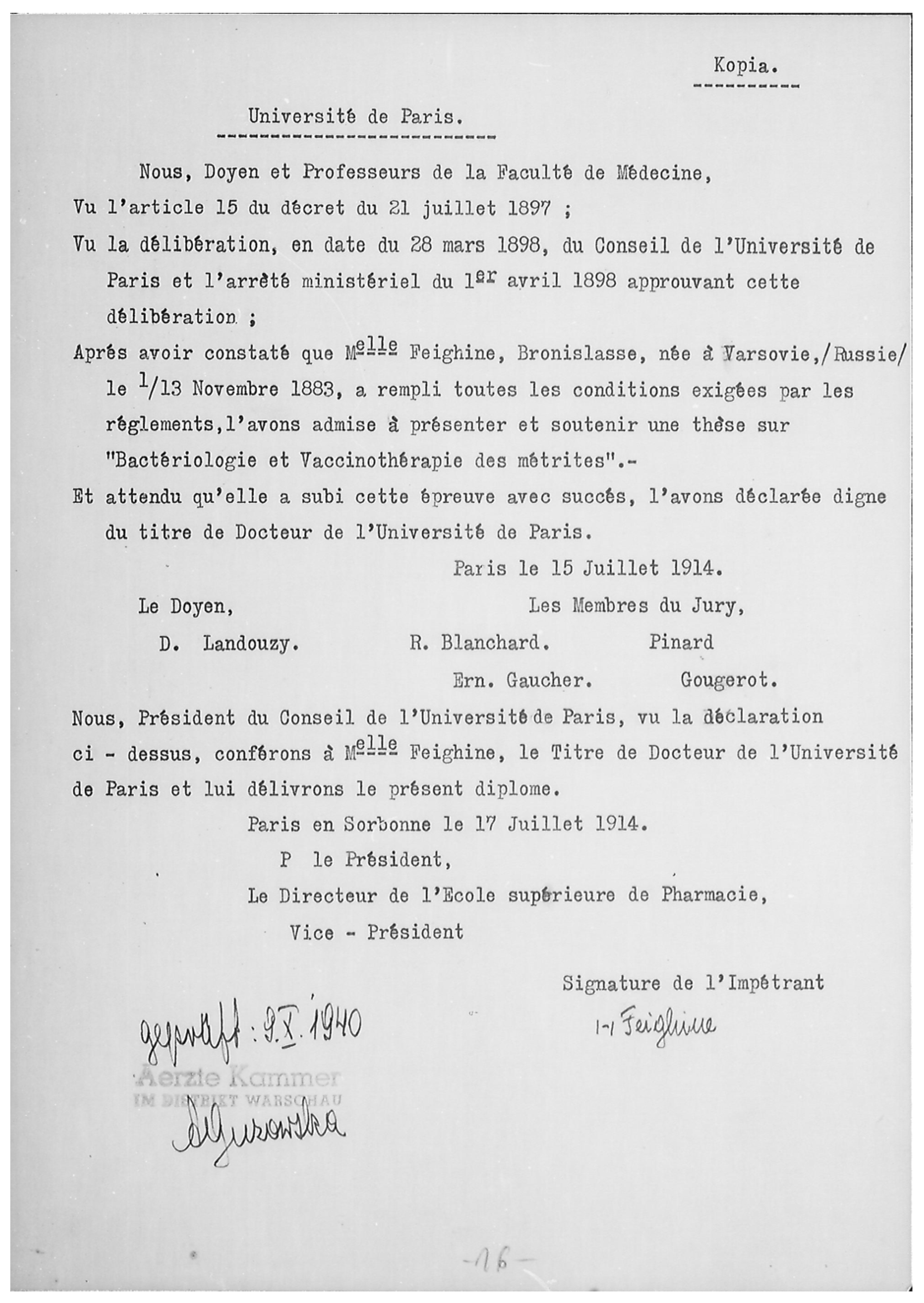Bronisława Fejgin (1883–1943): Forgotten Important Contributor to International Microbiology and Phage Therapy
Abstract
:1. Introduction
2. Methodology
3. Biography
4. Analysis of Scientific Contributions
5. Perception of Fejgin’s Work among Other Authors
6. Conclusions
Author Contributions
Funding
Institutional Review Board Statement
Informed Consent Statement
Conflicts of Interest
References
- Summers, W.C. The strange history of phage therapy. Bacteriophage 2012, 2, 130–133. [Google Scholar] [CrossRef] [PubMed] [Green Version]
- Gromulska, M. Uczone Asystentki, Genialne Laborantki i Ciche Wolontariuszki–Pierwsze Kobiety Zatrudnione w Państwowym Zakładzie Higieny w Latach 1919–1925; Rocznik PZH: Warsaw, Poland, 1998; p. 404. (In Polish) [Google Scholar]
- Blum-Bielicka, L. Szkoła Pielęgniarstwa przy Szpitalu Starozakonnych w Warszawie (1923–1943). Wspomnienia. Biul. Żyd. Inst. Historycznego 1961, 40, 72–73. (In Polish) [Google Scholar]
- Ciesielska, M. Lekarze Getta Warszawskiego; Wydawnictwo Dwa Światy: Warsaw, Poland, 2018; p. 130. (In Polish) [Google Scholar]
- Engelking, B.; Leociak, J. The Warsaw Ghetto; Yale University Press: New Haven, CT, USA, 2009. [Google Scholar]
- Falstein, L. The Martyrdom of Jewish Physicians in Poland; Exposition Press: New York, NY, USA, 1963. [Google Scholar]
- Gliński, J.B. Fejgin Brandla Bronisława. Słownik Biograficzny Lekarzy i Farmaceutów Ofiar Drugiej Wojny Światowej; Wydawnictwo JMP: Warsaw, Poland, 1999; p. 134. (In Polish) [Google Scholar]
- Roland, C.G. An underground medical school in the Warsaw ghetto, 1941–1942. Med. Hist. 1989, 33, 399–419. [Google Scholar] [CrossRef] [Green Version]
- Wiesz, G.M.; Grzybowski, A. Remembering more Jewish physicians. Rambam Maimon. Maimonides J. 2016, 7, e0026. [Google Scholar] [CrossRef] [PubMed]
- Weisz, G.M.; Grzybowski, A.; Albury, W.R. The fate of the Warsaw Ghetto Medical Faculty. Isr. Med. Assoc. J. 2012, 14, 209–213. [Google Scholar]
- Bertrand, D.M.; Fejgin, B. Contribution a l’etude de la flore bacterienne des infections uterines. C. R. Soc. Biol. 1913, séance du 5 juillet, 956. (In French) [Google Scholar]
- Bertrand, D.M.; Fejgin, B. Examen bacteriologique de quelques cas de metrite et traitement par les virus-vaccins sensibilises. C. R. Soc. Biol. 1913, 921. (In French) [Google Scholar]
- Fejgin, B.; Epstein, T.; Funk, C. Sur une tumeur vegetale provoquee par une bacterie isolee d’un carcinoma humain. C. R. Soc. Biol. Soc. Pol. Biol. 1926, séance du 24 mars, 1097–1098. (In French) [Google Scholar]
- Fejgin, B. Sur les variations brusques du Proteus HX19 survenues sous l’influence de l’agent lytique anti-HX19 et leur rap-port avec les souches isolees des cobayes infectes avec le virus de passage du typhus exanthematique. C. R. Soc. Biol. 1924, 90, 1106–1108. (In French) [Google Scholar]
- Weynberg, K.D. Viruses in Marine Ecosystems: From Open Waters to Coral Reefs. Adv. Virus Res. 2018, 101, 1–38. [Google Scholar] [CrossRef]
- Coetzee, J.N.; Sacks, T.G. Lysogeny in the Genus Proteus. Nat. Cell Biol. 1959, 184, 1340. [Google Scholar] [CrossRef]
- Fejgin, B.; Supniewski, J. Sur la nature du phenomene de d’Herelle. C. R. Soc. Biol. 1923, II, 1385–1386. (In French) [Google Scholar]
- Fejgin, B. O zmienności bakteryj w związku ze zjawiskiem d’Herella. Warsz. Czas. Lekarskie 1927, 21, 694–697. (In Polish) [Google Scholar]
- Fejgin, B. Etudes sur les microbes marins. III. Etude sur la flore bacterienne des Ascidies. Bull. Inst. Océanogr. 1931, 584, 1–4. (In French) [Google Scholar]
- Fejgin, B. Contribution a l’etude des races resistances du Bacille de Shiga-Kruse. C. R. Soc. Biol. 1923, II, 1381–1383. (In French) [Google Scholar]
- De Angelis, L.H.; Poerio, N.; Di Pilato, V.; De Santis, F.; Antonelli, A.; Thaller, M.; Fraziano, M.; Rossolini, G.; D’Andrea, M. Phage Resistance Is Associated with Decreased Virulence in KPC-Producing Klebsiella pneumoniae of the Clonal Group 258 Clade II Lineage. Microorganisms 2021, 9, 762. [Google Scholar] [CrossRef] [PubMed]
- Oeschlin, F. Resistance Development to Bacteriophages Occurring during Bacteriophage Therapy. Viruses 2018, 10, 351. [Google Scholar]
- Sumrall, E.T.; Shen, Y.; Keller, A.P.; Rismondo, J.; Pavlou, M.; Eugster, M.R.; Boulos, S.; Disson, O.; Thouvenot, P.; Kilcher, S.; et al. Phage resistance at the cost of virulence: Listeria mon-ocytogenes serovar 4b requires galactosylated teichoic acids for InlB-mediated invasion. PLoS Pathog. 2019, 15, e1008032. [Google Scholar] [CrossRef] [Green Version]
- Fruciano, D.E.; Bourne, S. Phage as an Antimicrobial Agent: D’herelle’s Heretical Theories and Their Role in the Decline of Phage Prophylaxis in the West. Can. J. Infect. Dis. Med. Microbiol. 2007, 18, 19–26. [Google Scholar] [CrossRef] [PubMed]
- Fejgin, B. Examen de quelques microbes isoles des matieres fecales. C. R. Soc. Biol. 1923, II, 1383–1385. (In French) [Google Scholar]
- Bruynoghe, R.; Maisin, J. Essais de thérapeutique au moyen du bacteriophage. C. R. Soc. Biol. 1921, 85, 1120–1121. (In French) [Google Scholar]
- Kuttner, A.G. Bacteriophage Phenomena. J. Bacteriol. 1923, 8, 49–101. [Google Scholar] [CrossRef] [Green Version]
- Fejgin, B. Sur le principe lytique anti-diphterique. C. R. Soc. Biol. Soc. Pol. Biol. 1925, 365–366. (In French) [Google Scholar]
- Fejgin, B.; Kuhx, W. Sur la toxicite du bacilli de Shiga bacteriophage. C. R. Soc. Biol. Soc. Biol. Vars. 1936, 259–260. (In French) [Google Scholar]
- Fejgin, B.; Epstein, T. Sur la resistance des Staphylocoques hemolysants vis-à-vis du bacteriophage specifique. C. R. Soc. Biol. 1926, 908–909. (In French) [Google Scholar]
- Hirszfeld, L.; Epsteinowna, T. Serological-bacteriological attempts at the diagnosis of typhus typhus. Pol Tyg Lek. 1946, 1, 329. [Google Scholar]
- Borges, A.L. How to train your bacteriophage. Proc. Natl. Acad. Sci. USA 2021, 118, 2109434118. [Google Scholar] [CrossRef]
- Jern, H.Z.; Howes, E.L.; Meleney, F.L. Studies in bacteriophage. I. The behavior of the bacteriophage and the bacteria in the lesion after the treatment of acute staphylococcus skin infections with bacteriophage. J. Lab. Clin. Med. 1934, 19, 1257–1271. [Google Scholar]
- McKinley, E.B. Staphylococci and Bacteriophagy. JAMA 1933, 100, 1276. [Google Scholar] [CrossRef]
- d’Herelle, F.; Rakieten, M.L. The susceptibility of hemolytic staphylococci to bacteriophage. JAMA 1933, 100, 1014. [Google Scholar] [CrossRef]
- Fejgin, B. Sur la forme invisible des bacteries dans l’eau de mer. C. R. Soc. Biol. 1926, 659. (In French) [Google Scholar]
- Fejgin, B.; Łazarewicz, M. A propos des bacteries obtenues a partir du Proteus X19 lyse. C. R. Soc. Biol. Soc. Pol. Biol. 1927, 342–344. (In French) [Google Scholar]
- Fejgin, B. Au sujet de la variabilite du Bacille HX19. C. R. Soc. Biol. Soc. Biol. Vars. 1933, 201–204. (In French) [Google Scholar]
- Abedon, S.T.; Thomas-Abedon, C.; Thomas, A.; Mazure, H. Bacteriophage prehistory: Is or is not Hankin, 1896, a phage reference? Bacteriophage 2011, 1, 174–178. [Google Scholar] [CrossRef] [PubMed] [Green Version]
- Weber-Dąbrowska, B.; Jończyk-Matysiak, E.; Żaczek, M.; Łobocka, M.; Łusiak-Szelachowska, M.; Górski, A. Bacteriophage Procurement for Therapeutic Purposes. Front. Microbiol. 2016, 7, 1177. [Google Scholar] [CrossRef]
- Fejgin, B.; Epstein, T. Sur la presence du bacteriophage au cours de la dysenterie epidemique a Krzemieniec (Pologne). C. R. Soc. Biol. Soc. Biol. Vars. 1935, 369–371. (In French) [Google Scholar]
- Fejgin, B.; Epstein, T. Sur la bacteriophage du colibacille. C. R. Soc. Biol. Soc. Biol. Vars. 1935, 1101–1103. (In French) [Google Scholar]
- Strong, R.P. The Relationship of Certain “Free-Living” and Saprophytic Microorganisms to Disease. Science 1925, 61, 97–107. [Google Scholar] [CrossRef]
- Hektoen, L.; Jordan, E.O. The preparation and precipitin reactions of egg albumin and blood proteins of the domestic fowl. J. Infect. Dis. 1927, 40, 647–655. [Google Scholar] [CrossRef]
- Żaczek, M.; Weber-Dąbrowska, B.; Międzybrodzki, R.; Łusiak-Szelachowska, M.; Górski, A. Phage Therapy in Poland—A Centennial Journey to the First Ethically Approved Treatment Facility in Europe. Front. Microbiol. 2020, 11, 1056. [Google Scholar] [CrossRef]
- Żaczek, M.; Weber-Dąbrowska, B.; Łusiak-Szelachowska, M.; Międzybrodzki, R.; Górski, A. Polish Contribution to the Ad-vancement of Phage Treatment in Humans. In Bacterial Viruses: Exploitation for Biocontrol and Therapeutics; Caister Academic Press: Norfolk, UK, 2020; pp. 187–202. [Google Scholar]
- Amsterdamska, O. Stabilizing Instability: The Controversy over Cyclogenic Theories of Bacterial Variation during the Interwar Period. J. Hist. Biol. 1991, 24, 191–222. [Google Scholar] [CrossRef] [PubMed]



Publisher’s Note: MDPI stays neutral with regard to jurisdictional claims in published maps and institutional affiliations. |
© 2021 by the authors. Licensee MDPI, Basel, Switzerland. This article is an open access article distributed under the terms and conditions of the Creative Commons Attribution (CC BY) license (https://creativecommons.org/licenses/by/4.0/).
Share and Cite
Grzybowski, A.; Żaczek, M.; Górski, A.; Weber-Dąbrowska, B.; Międzybrodzki, R. Bronisława Fejgin (1883–1943): Forgotten Important Contributor to International Microbiology and Phage Therapy. Antibiotics 2021, 10, 1353. https://doi.org/10.3390/antibiotics10111353
Grzybowski A, Żaczek M, Górski A, Weber-Dąbrowska B, Międzybrodzki R. Bronisława Fejgin (1883–1943): Forgotten Important Contributor to International Microbiology and Phage Therapy. Antibiotics. 2021; 10(11):1353. https://doi.org/10.3390/antibiotics10111353
Chicago/Turabian StyleGrzybowski, Andrzej, Maciej Żaczek, Andrzej Górski, Beata Weber-Dąbrowska, and Ryszard Międzybrodzki. 2021. "Bronisława Fejgin (1883–1943): Forgotten Important Contributor to International Microbiology and Phage Therapy" Antibiotics 10, no. 11: 1353. https://doi.org/10.3390/antibiotics10111353
APA StyleGrzybowski, A., Żaczek, M., Górski, A., Weber-Dąbrowska, B., & Międzybrodzki, R. (2021). Bronisława Fejgin (1883–1943): Forgotten Important Contributor to International Microbiology and Phage Therapy. Antibiotics, 10(11), 1353. https://doi.org/10.3390/antibiotics10111353






